|
|
|
Sort Order |
|
|
|
Items / Page
|
|
|
|
|
|
|
| Srl | Item |
| 1 |
ID:
183563


|
|
|
|
|
| Summary/Abstract |
Financial incentives, such as rebate programs, are widely used to promote the adoption of residential solar photovoltaic systems. This paper studies the changing effectiveness of rebate programs as the solar market evolves. We develop a theoretical model to first characterize individual treatment effects then aggregate them to regional effect, and hypothesize that the aggregate treatment effect of rebates first increases and then decreases with declining costs and increasing net metering rate. We empirically test our hypotheses by estimating the treatment effect of rebate rate in California from 2006 to 2017 and its interaction terms with installation cost and residential electricity rate. Results confirm our hypotheses and identify an installation cost of $8.84/W and a residential electricity rate of 22.36c/kWh as the turning points where rebate impacts start to decline. Our findings suggest that front-loaded rebate rate design can be an effective and efficient tool at promoting residential solar adoption.
|
|
|
|
|
|
|
|
|
|
|
|
|
|
|
|
| 2 |
ID:
132604


|
|
|
|
|
| Publication |
2014.
|
| Summary/Abstract |
The United Kingdom is aspiring to reduce the carbon emissions in the building sector, aiming to achieve nearly zero carbon buildings by 2020. The policy models in England and Wales rely on three strands: regulations; financial incentives and educational schemes. A growing body of literature suggests that the building industry is facing several barriers that hinder the delivery of the expected carbon targets outlined at policy level. This research explores the enactment of the policy aspirations by building designers using a bottom-up approach. An ethnographic study was conducted to analyse the design process of six non-domestic buildings. The work identified the designers× responses to adopt the policy agenda in routine design and overcome the challenges that emerged during the design process. The understanding of the designers× responses could inform the policy model and suggest areas that need attention for the timely delivery of the expected carbon reductions.
|
|
|
|
|
|
|
|
|
|
|
|
|
|
|
|
| 3 |
ID:
132618


|
|
|
|
|
| Publication |
2014.
|
| Summary/Abstract |
The reuse of Li-ion EV batteries for energy storage systems (ESS) in stationary settings is a promising technology to support improved management of demand and supply of electricity. In this paper, MatLAB simulation of a residential energy profile and regulated cost structure is used to analyze the feasibility of and cost savings from repurposing an EV battery unit for peak-shifting. in situ residential energy storage can contribute to the implementation of a smart grid by supporting the reduction of demand during typical peak use periods. Use of an ESS increases household energy use but potentially improves economic effectiveness and reduces greenhouse gas emissions. The research supports the use of financial incentives for Li-ion battery reuse in ESS, including lower energy rates and reduced auxiliary fees.
|
|
|
|
|
|
|
|
|
|
|
|
|
|
|
|
| 4 |
ID:
149884


|
|
|
|
|
| Summary/Abstract |
Whilst tariff-based approaches to load-shifting are common in the residential sector, incentive-based approaches are rare. This is so, even though providing customers incentives to shape their power consumption patterns has substantial potential. This paper presents findings from an exploratory UK pilot study that trials financial payments and detailed energy feedback to incentivise load-shifting of residential electricity consumption.
|
|
|
|
|
|
|
|
|
|
|
|
|
|
|
|
| 5 |
ID:
132643


|
|
|
|
|
| Publication |
2014.
|
| Summary/Abstract |
The promotion of energy efficiency is seen as one of the top priorities of EU energy policy (EC, 2010). In order to design and implement effective energy policy instruments, it is necessary to have information on energy demand price and income elasticities in addition to sound indicators of energy efficiency. This research combines the approaches taken in energy demand modelling and frontier analysis in order to econometrically estimate the level of energy efficiency for the residential sector in the EU-27 member states for the period 1996 to 2009. The estimates for the energy efficiency confirm that the EU residential sector indeed holds a relatively high potential for energy savings from reduced inefficiency. Therefore, despite the common objective to decrease 'wasteful' energy consumption, considerable variation in energy efficiency between the EU member states is established. Furthermore, an attempt is made to evaluate the impact of energy-efficiency measures undertaken in the EU residential sector by introducing an additional set of variables into the model and the results suggest that financial incentives and energy performance standards play an important role in promoting energy efficiency improvements, whereas informative measures do not have a significant impact.
|
|
|
|
|
|
|
|
|
|
|
|
|
|
|
|
| 6 |
ID:
112934


|
|
|
|
|
| Publication |
2012.
|
| Summary/Abstract |
Many states have adopted financial incentives to encourage market deployment of solar energy technology. This paper employs a cross-sectional time-series approach to evaluate the extent to which state solar financial incentives systematically encouraged market deployment of solar photovoltaic (PV) technology from 1997 to 2009. The results demonstrate that states offering cash incentives such as rebates and grants experienced more extensive and rapid deployment of grid-tied PV technology than states without cash incentives over the study period. The analysis also finds that the presence of state renewable energy portfolio standards and specific solar carve-out provisions within them heavily influenced the market deployment of grid-tied solar PV technology through 2009.
|
|
|
|
|
|
|
|
|
|
|
|
|
|
|
|
| 7 |
ID:
159051
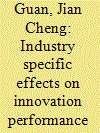

|
|
|
|
|
| Summary/Abstract |
This research aims to understand how industrial characteristics in Chinese industrial sectors are related to and affect innovation activities. Using Heckman's two-step procedure, this study contributes to examine firms' innovation determinants with a framework that clearly distinguishes between the two steps of innovation model: innovation propensity (probability of being innovative) and innovation performance (patents and innovation sales). In particular, the moderating effects of industrial characteristics on the relationships between R&D intensity, financial incentives and innovation performance are discussed. The findings show that different industrial characteristics generate different impacts on innovation propensity and innovation performance. Firms in capital intensive industries and relative monopoly industries are more likely to innovate. The findings also show that Direct Government Subsidy does not contribute significantly to improve economical innovation performance of firms and Indirect Government Subsidy on innovative economic performance is easier to be influenced by industry characteristics, which have important potential policy implications to guide innovation activities for Chinese policy makers as well as for Chinese firms.
|
|
|
|
|
|
|
|
|
|
|
|
|
|
|
|
| 8 |
ID:
133088


|
|
|
|
|
| Publication |
2014.
|
| Summary/Abstract |
Electric vehicles represent an innovation with the potential to lower greenhouse gas emissions and help mitigate the causes of climate change. However, externalities including the appropriability of knowledge and pollution abatement result in societal/economic benefits that are not incorporated in electric vehicle prices. In order to address resulting market failures, governments have employed a number of policies. We seek to determine the relationship of one such policy instrument (consumer financial incentives) to electric vehicle adoption. Based on existing literature, we identified several additional socio-economic factors that are expected to be influential in determining electric vehicle adoption rates. Using multiple linear regression analysis, we examined the relationship between those variables and 30 national electric vehicle market shares for the year 2012. The model found financial incentives, charging infrastructure, and local presence of production facilities to be significant and positively correlated to a country×s electric vehicle market share. Results suggest that of those factors, charging infrastructure was most strongly related to electric vehicle adoption. However, descriptive analysis suggests that neither financial incentives nor charging infrastructure ensure high electric vehicle adoption rates.
|
|
|
|
|
|
|
|
|
|
|
|
|
|
|
|
| 9 |
ID:
132639
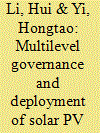

|
|
|
|
|
| Publication |
2014.
|
| Summary/Abstract |
Solar photovoltaic (PV) installations have been growing rapidly in the United States over the last few years, incentivized by policies from federal, state and local governments. The complex relationships between solar policies at multiple levels of government and solar deployment are questions of importance to policy makers and scholars. Extant literature on solar policies pays less attention to the role of local governments and policies than to their federal and state counterparts. Local governments and policies play indispensable roles in the deployment of solar PVs. This paper studies the multilevel governance of solar development in the U.S. by evaluating the relative effectiveness of state and local policy tools in stimulating solar PV installations, with an emphasis on local solar policies. With a regression analysis on a national sample of 186 U.S. cities, we find that cities with local financial incentives deploy 69% more solar PV capacities than cities without such policies. We also find that cities subject to RPS requirements have 295% more solar PV capacity, compared with cities not regulated by state RPS.
|
|
|
|
|
|
|
|
|
|
|
|
|
|
|
|
| 10 |
ID:
162454


|
|
|
|
|
| Summary/Abstract |
Developing states furnish the vast majority of UN peacekeeping troops, a fact academics and policymakers often attribute (at least partly) to developing states’ supposed ability to derive a profit from UN peacekeeping reimbursements. In this article, we argue that this ‘peacekeeping for profit’ narrative has been vastly overstated. The conditions for significantly profiting from UN peacekeeping are in fact highly restrictive, even for developing states. We begin by highlighting two potent reasons for re-examining the peacekeeping for profit narrative: developing states emerged as the UN’s principal troop contributors in a period of stagnant reimbursement rates when UN peacekeeping was becoming less financially attractive; and the quantitative evidence scholars have presented as supporting the peacekeeping for profit narrative is flawed. We then identify the scope conditions within which peacekeeping for profit provides a plausible explanation for a developing state’s UN troop contributions. First, the deployment and its attendant reimbursements must be significant not only in absolute and per-soldier terms but also in relation to the state’s total armed forces and military expenditure. Second, the state must have an exceptional ability, compared with other troop contributors, to benefit from UN reimbursements. The scope for generalized profit-making from either equipment or personnel contributions is limited by intense political pressure against reimbursement rate increases. Individual states can nevertheless make a profit if they (1) invest in inexpensive and old but functional equipment, especially if deployed with usage restrictions, and/or (2) limit the deployment allowances (rather than salaries) they pay their peacekeepers. We establish that only a limited subset of developing states meets the plausibility conditions for the peacekeeping for profit narrative – and many top UN troop contributors do not.
|
|
|
|
|
|
|
|
|
|
|
|
|
|
|
|
| 11 |
ID:
162896
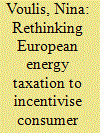

|
|
|
|
|
| Summary/Abstract |
The European Union considers demand response to be an integral part of its future energy vision, in particular as a supporting mechanism for renewable resource integration. To achieve high demand response participation, the European Union recognises the need for adequate financial incentives for all consumers, especially for residential and service sector consumers. However, the European Energy Tax Directive, which regulates energy taxation in the European Union, is currently not in alignment with this vision, as it does not provide any financial incentives for demand response participation. This paper explores the potential of energy taxes to provide such incentives. First, through an analysis of the current energy taxation and demand response literature. Second, by quantifying the difference in financial incentives between two tax designs (per-unit and ad valorem taxes) in a simulation case study of consumers heat pumps in the Netherlands. Results show that financial incentives are 3.5 times higher for the ad valorem tax than for the per-unit tax. The paper concludes with recommendations for policy makers for the design of energy taxes that provide residential and service sector consumers with adequate financial incentives for demand response participation.
|
|
|
|
|
|
|
|
|
|
|
|
|
|
|
|
| 12 |
ID:
184106
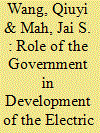

|
|
|
|
|
| Summary/Abstract |
As one of the technology-intensive industries, the electric vehicle (EV) industry has attracted the attention of the Chinese government. It has provided various incentives for the purchase of EVs, including tax incentives, policy loans at preferential interest rates and the establishment of charging facilities. EV production technology developed rapidly and sales of EVs increased significantly during the 2010s. The role of the government seems to have been of vital importance to the rapid development of the EV industry in China. To improve this further, it would be helpful for the government to efficiently coordinate various policy measures benefitting the EV industry and create a more suitable social environment for consumers to use EVs. The government should also carefully consider how to improve the applicability of EVs in different regional surroundings. In addition, efficient collaboration between the electronics industry and the automobile industry would be critical.
|
|
|
|
|
|
|
|
|
|
|
|
|
|
|
|
| 13 |
ID:
132663


|
|
|
|
|
| Publication |
2014.
|
| Summary/Abstract |
This study documents and analyzes the role of health risk perceptions and other associated concerns of wind energy development (henceforth WED) in Ontario. Drawing on the risk society framework, we conduct a longitudinal media content analysis to document and analyze perceptions of and responses to WED over a nine year period. Attention is paid to temporal variations in responses relative to Ontario×s Green Energy Act (2009) (henceforth GEA); legislation aimed at the rapid expansion of renewable energy. The study reveals that the most radical forms of resistance to WED on health grounds are driven by perceived injustices in the treatment of potential at-risk citizens and citizens with health concerns. The GEA is fuelling these perceptions of injustices in subtle and nuanced ways, particularly by acting as a major confounder to health risk concerns. Contrary to several existing studies, we problematize the use of financial incentives to foster the development of wind energy. We also provide policy recommendations which include the need for increased public engagement in the WED process, the importance of using third party health and environmental assessments to inform developments as well as the need for post-development strategies to address ongoing community concerns.
|
|
|
|
|
|
|
|
|
|
|
|
|
|
|
|
| 14 |
ID:
171467


|
|
|
|
|
| Summary/Abstract |
Sustainable energy requires renewable energy sources to reduce reliance on fossil fuels. As a renewable energy source, first-generation bioethanol has been produced from corn. However, the production of such a biofuel increases corn-based food prices resulting in serious food versus fuel debates. Financial incentives would motivate first-generation bioethanol producers switching to second-generation bioethanol production. This study investigates the effects of two financial incentives (incentive payments and emissions penalties) motivating first-generation bioethanol producers to use second-generation biomass. These financial incentives are integrated into linear programming models to maximize the profit of the bioethanol supply chains in the state of North Dakota. Numerical results indicate that first-generation bioethanol production is more efficient than the second-generation bioethanol. Hence, the social value of using corn as a source for food instead of fuel must be at least $2.38/bushel. Furthermore, to switch from the first to the second-generation biofuel production, bioethanol producers must either receive at least an incentive payment of $0.8495 per gallon of second-generation bioethanol or pay at least a penalty of $3.2573 per Kg CO2e emitted due to first-generation bioethanol production. The results of this study support policymaker decisions in developing incentive programs to promote sustainable second-generation bioethanol in the US.
|
|
|
|
|
|
|
|
|
|
|
|
|
|
|
|
| 15 |
ID:
176805
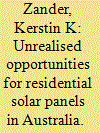

|
|
|
|
|
| Summary/Abstract |
Rooftop solar power production is particularly relevant to climate change mitigation in Australia given the country's high insolation rates. However, residential adoption rates vary across the country with potential for increasing uptake, particularly on apartment buildings and rental properties. This study focuses on past and future motivations for the adoption of rooftop solar panels and the barriers people perceive upon adoption. An online survey was conducted with 1126 respondents across Australia showing that 65% of those who had no solar panels were intending to adopt them. Results of best-worst scaling showed that motivations for past and future adoptions did not differ significantly and that economic motivations predominated, particularly for homeowners. Renters, a group often overlooked in the production of solar energy, strongly desired solar panels, often for environmental reasons, but were discouraged by uncertainties about the costs and benefits of installing solar. This reveals a need for policies that help renters and landlords, and those in multi-unit dwellings, to find ways in which the costs and benefits can be shared equitably. This will become more important as energy costs rise and urbanisation intensifies.
|
|
|
|
|
|
|
|
|
|
|
|
|
|
|
|
|
|
|
|
|